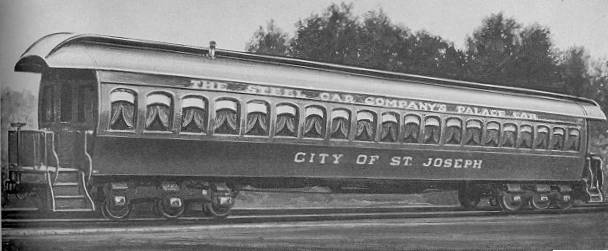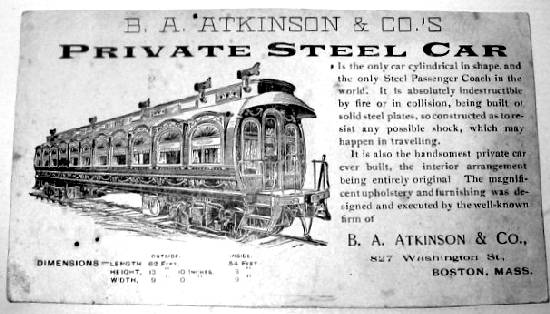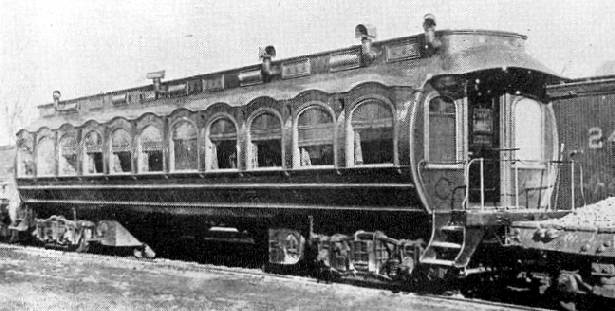Steel Car Company - Page 2
Perky finally found backing in St. Joseph, Missouri, and there, late in 1888, at a cost of some $70,000 (more than $1.4 million in today’s buying power), he erected an 80' x 960' building on a large plot of land east of the city “beyond Wyatt Park.” He also organized an exposition, to be called the National Railway, Electric and Industrial Exposition, more popularly known as the “New Era Exposition.” The exposition was set up on the grounds of the Steel Car Company, with the western portion of its building, which was two stories tall, as the main hall of the exposition. A second passenger car was built before the exposition opened, apparently by the Bouton Foundry in Chicago, a firm owned and operated by Nathaniel S. Bouton, who had some experience in building cars at the Union Car Works. This car was much more conventional than the previous one. The diameter of the basic body structure was larger so that the windows could be inset into it rather than being projecting “dormers.” It was also longer, and rode on six-wheeled trucks. And it was outfitted as a private car with an observation area, bedrooms and dining area. It was named—obviously—the City of St. Joseph.
The City of St. Joseph was a major attraction at the exposition. In the summer of 1889, while it was being exhibited, 10 more like it were being built in the nearby shops. But then came the unexpected. On the night of 15 September 1889 a fire of undetermined origin swept through the main building of the exposition (remember, it was also the Steel Car Company’s shops building). The City of St. Joseph, the ten cars being built, the Steel Car Company plant, all the assets of the Steel Car Company—and its prospects—literally went up in smoke! Henry Perky was not one to be easily discouraged. He took the original car, which had been outfitted as a private car for Atkins’ personal use, for a transcontinental tour. But though it attracted a good deal of attention, it attracted no orders.
The cylindrical car, as it was generally called, was shown at the 1893 Columbian Exposition in Chicago, but again attracted no orders. Although almost $40,000 had been spent on it (close to $1 million in today’s buying power), when the exposition closed, it was abandoned on the fairgrounds and later sold by the firm that dismantled the Exposition. It went through a succession of owners, and may even have been used as a crew car before finally disappearing into oblivion sometime during the Great Depression.
We don’t know what happened to the Steel Car Company. Presumably it went bust like so many other innovators ahead of their time. But we do know what happened to Henry D. Perky. Sometime in the early 1890s, at a Nebraska hotel, Perky—who suffered from heartburn—encountered a man similarly afflicted, who was eating boiled wheat with cream. The idea cooked for awhile in Perky’s mind, and with the help of William H. Ford of Watertown, New York, he developed a machine to produce what he called “little whole wheat mattresses,” He first tried to sell his machine as a do-it-yourself gadget for home use, but without great success. In 1895, he got a patent on the product (no. 548,086, dated 15 October 1895), started his own company and began large scale production. The Natural Food Company Henry Perky founded at Niagara, New York, eventually became part of the National Biscuit Company. And the product Henry D. Perky invented was Shredded Wheat! For More Information —Holechek, Jim. Henry Perky; The Shredded Wheat King. Lincoln, NE: iUniverse, Inc., 2007.
White, John H. Jr., The American Railroad Passenger Car. Baltimore, MD: Johns Hopkins University Press, 1978, pp. 124ff.
Back to page 1 |


